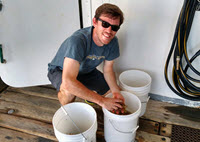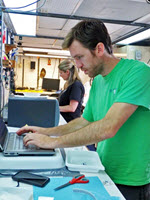
The deep-pelagic habitat (200 m depth to just above the seabed) is the largest habitat in the Gulf of Mexico, yet we know very little about it compared to coastal and shallow-water habitats. Our limited understanding of this major marine habitat makes it extremely difficult to assess the effects of disturbances such as the Deepwater Horizon oil spill. Travis Richards seeks to better understand the structure of deep-pelagic food webs by tracing the energy flow from the food web base through higher trophic levels. His research will help expand our understanding of the deep-pelagic habitat and serve as a reference point for future studies and response efforts.
Travis is a Ph.D. student at Texas A&M University at Galveston’s Marine Biology Department and a GoMRI Scholar with the Deep-Pelagic Nekton Dynamics of the Gulf of Mexico (DEEPEND) consortium.
His Path

Travis discovered his interest in biology through the many scientists and science educators in his family who exposed him to diverse habitats and species through frequent camping, fishing, and hiking trips. His family’s travels took him to sites across the United States, including several trips to the Gulf of Mexico coastline. During his undergraduate and graduate career, he explored a variety of marine ecology opportunities and developed a specialization in marine food webs. He had just completed an ecology and evolutionary biology master’s degree at Florida State University when Dr. David Wells at Texas A&M University at Galveston contacted him about a Ph.D. student position researching deep-sea food webs. He eagerly accepted and joined Wells’ lab team working on the DEEPEND project.
Travis explained that the immersive outdoor experiences of his childhood have become a large part of his identity and are a driving force behind his research interests. “Those transformative experiences give conducting research on marine Gulf of Mexico organisms a personal significance,” he said. “I now have a career pursuing a field that interested me since childhood and contributing to our understanding of an ecosystem that played a significant role in my life.”
His Work

Travis helps collect deep-pelagic organisms using a Multiple Opening and Closing Net with Environmental Sensing System (MOCNESS) that is towed from surface waters to 1500 m depth. He analyzes natural chemical tracers called stable isotopes (variants of chemical elements that have a distinct signature as they transfer from prey to predator) in different organisms’ muscle tissues to identify their position within the food web. He can then piece together the food web’s structure to trace the initial food source and document the natural flow of energy through the food web.
Travis will use the data to describe variation in food web structure, identify the number of deep-pelagic trophic groups with different functions, and determine how much deep-pelagic organisms contribute to the diets of demersal (near the seabed) and epipelagic (surface to 200 m depth) predators. So far, Travis has observed that deep-pelagic food webs are more complex and nuanced than researchers have previously thought. His preliminary results indicate that the food web’s structure varies both seasonally and across horizontal and vertical spatial scales. Researchers can use this information to make better predictions about the ways that removal of targeted species by fisheries or disturbances such as oil spills will affect the food web and the greater pelagic ecosystem.
His Learning

Travis has learned that productivity matters to success in academia. One must always make progress on some aspect of their research, and there is always a paper that needs work or an experiment that can be set up. He said that seeing the contributions of one’s research is a motivating reward for the hard work. “I’m continually impressed with the research being conducted within the different GoMRI funded projects. When you attend a GoMRI meeting, you get a real sense for how much we’re learning about the Gulf of Mexico. It’s exciting to know that our work is contributing to a new and more complete understanding of the Gulf.”
One of Travis’s most memorable experiences working with the DEEPEND consortium is conducting field work – a rare opportunity due to the challenging logistics and expensive nature of deep-sea sampling. “You never know what you’ll bring up in the nets,” he said. “With each research cruise, I’ve been able to see incredibly unique organisms, such as anglerfishes, lanternfishes, and cephalopods, that I never imagined I’d get to see in person.”
His Future
Travis hopes to conduct research as a post-doc and eventually take a position at a liberal arts college teaching and leading a small research program. He advises that students considering a scientific career take advantage of every research opportunity available to them, even those not focused on their exact interests. “Do the best possible work you can at each position you take,” he said. “Once you demonstrate your ability to perform well at a variety of positions, more opportunities will start to open up for you.”
Praise for Travis
Dr. Wells commended Travis’ commitment to leading the deep-sea trophic ecology component of the project’s research, noting that he often puts in extra time to make his research responsibilities his primary task. “He is always willing to participate on cruises and be involved in meetings and present his results,” said Wells. “He recently published his first dissertation chapter in ICES Journal of Marine Science (Trophic Ecology of Meso- and Bathypelagic Predators in the Gulf of Mexico) and is clearly on track to do great things with his project.”
The GoMRI community embraces bright and dedicated students like Travis Richards and their important contributions. The GoMRI Scholars Program recognizes graduate students whose work focuses on GoMRI-funded projects and builds community for the next generation of ocean science professionals. Visit the DEEPEND website to learn more about their work.
************
The Gulf of Mexico Research Initiative (GoMRI) is a 10-year independent research program established to study the effect, and the potential associated impact, of hydrocarbon releases on the environment and public health, as well as to develop improved spill mitigation, oil detection, characterization and remediation technologies. An independent and academic 20-member Research Board makes the funding and research direction decisions to ensure the intellectual quality, effectiveness and academic independence of the GoMRI research. All research data, findings and publications will be made publicly available. The program was established through a $500 million financial commitment from BP. For more information, visit https://gulfresearchinitiative.org/.
© Copyright 2010-2018 Gulf of Mexico Research Initiative (GoMRI) – All Rights Reserved. Redistribution is encouraged with acknowledgement to the Gulf of Mexico Research Initiative (GoMRI). Please credit images and/or videos as done in each article. Questions? Contact web-content editor Nilde “Maggie” Dannreuther, Northern Gulf Institute, Mississippi State University (maggied@ngi.msstate.edu).
